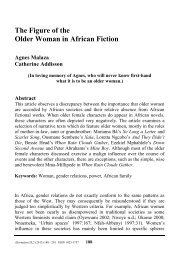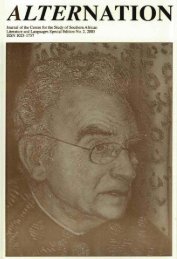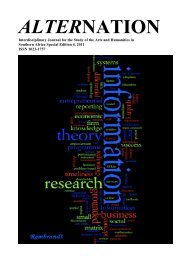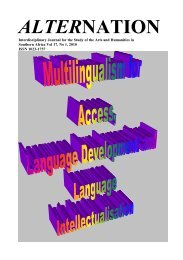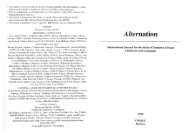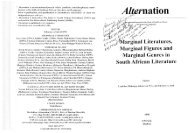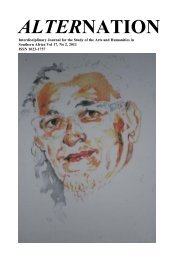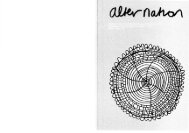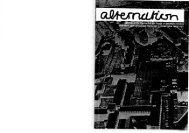Re-reading The Purloined Letter - Alternation Journal
Re-reading The Purloined Letter - Alternation Journal
Re-reading The Purloined Letter - Alternation Journal
Create successful ePaper yourself
Turn your PDF publications into a flip-book with our unique Google optimized e-Paper software.
Pravina Pillay<br />
heart of Poe’s ‘original’ is a repetition: it is a narrative within a narrative, as<br />
the story is itself told (repeated) by the ‘I’ narrator who hears and repeats the<br />
tale of the filched letter, which is retrieved through the same pattern of the<br />
original filching. <strong>The</strong> original repetition is then critically repeated. Thus, at<br />
the heart of the story itself lies both an absence and a pattern of repetition,<br />
which is then mimicked in subsequent <strong>reading</strong>s which try to find the text out.<br />
Williams (1995:56) believes that Poe is himself already <strong>The</strong> <strong>Purloined</strong> Poe<br />
culturally retrieved through the same strategies suggested by his own text.<br />
<strong>The</strong> story’s second scene—which repeats the story’s ‘primal scene’ but with<br />
a difference—is also the key to how Lacan understands the text as allegory.<br />
Williams (1995:56f) views this as repetition with understanding: the<br />
narrative repeats as psychoanalysis does, reworking and unknotting anxieties<br />
of psychic pre-history. Thus, it is only with the second scene that the whole<br />
story emerges as an allegory of the psychoanalytic situation, with Dupin<br />
acting as analyst in ‘restoring’ the Queen to herself. Of this, Shoshana<br />
Felman (1980:147) writes:<br />
In what sense, then, does the second scene in Poe’s tale, while<br />
repeating the first scene, nonetheless differ from it? In the sense,<br />
precisely, that the second scene, through the repetition, allows for an<br />
understanding, for an analysis of the first. This analysis through<br />
repetition is to become, in Lacan’s ingenious <strong>reading</strong>, no less than an<br />
allegory of psychoanalysis. <strong>The</strong> intervention of Dupin, who restores<br />
the letter to the Queen, is thus compared, in Lacan’s interpretation,<br />
to the intervention of the analyst, who rids the patient of the<br />
symptom.<br />
Williams (1995:57) stresses two points of difference, both of which are<br />
highlighted by Felman in her <strong>reading</strong> of Lacan’s essay. First, the way in<br />
which Lacan handles Poe’s narrative repetition-with-difference is important<br />
to our understanding of identity in his work. Felman (1980:148) says:<br />
… for Lacan, any possible insight into the reality of the unconscious<br />
is contingent upon a perception of repetition, not as a confirmation<br />
of identity, but as the insistence of the indelibility of a difference.<br />
372



